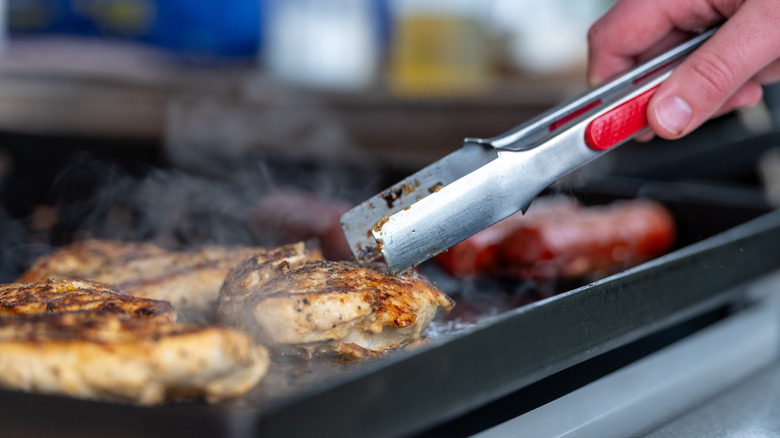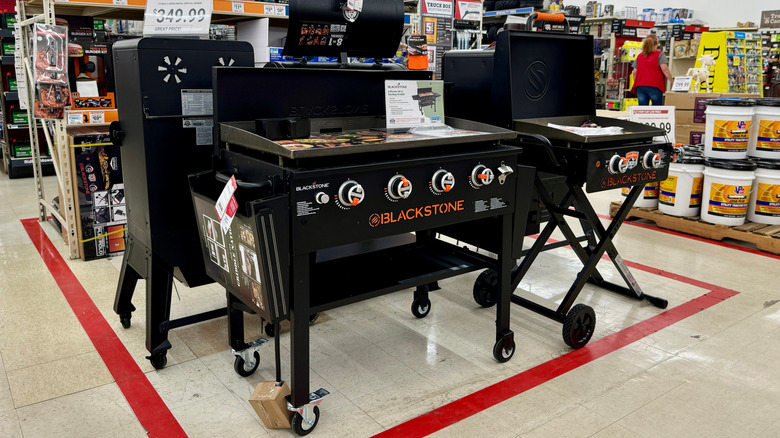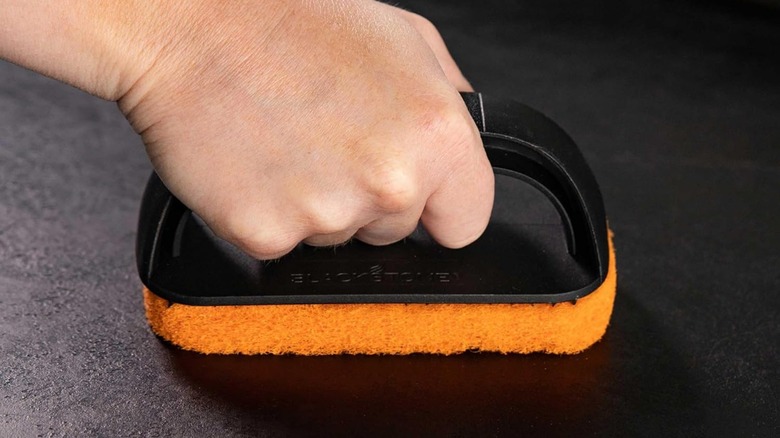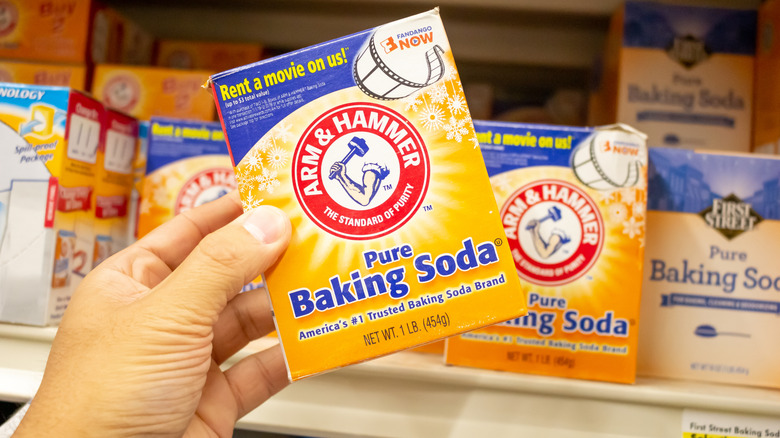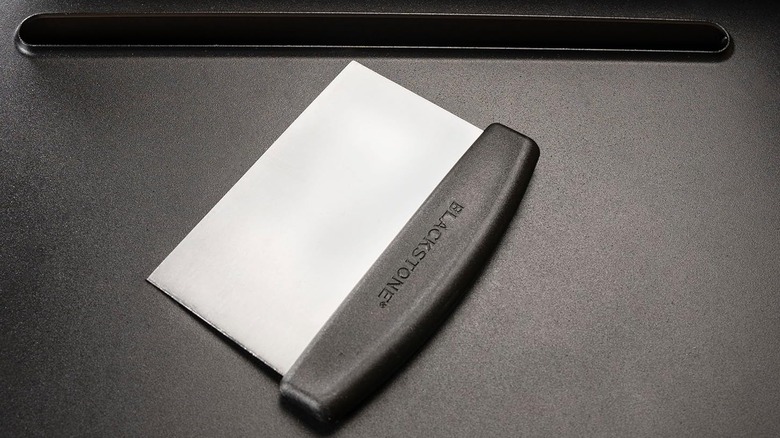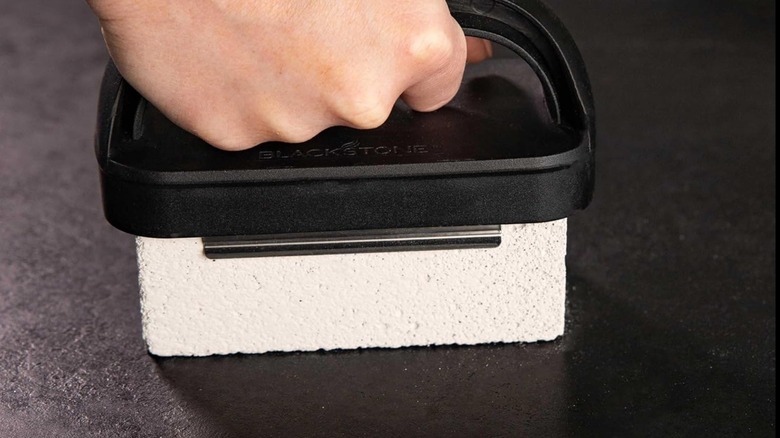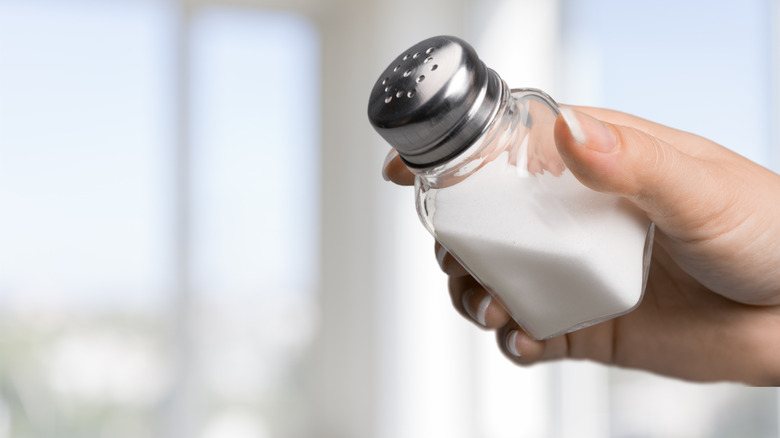6 Ways To Clean A Blackstone To Get Your Grill In Tip-Top Shape For Summer
We may receive a commission on purchases made from links.
Blackstones offer a unique alternative to cooking with a standard grill. Instead of the metal grates that a grill has, they feature a large, flat griddle top. This can allow for more versatile cooking options. You can even prepare foods like pancakes or eggs on a Blackstone. Plus, you don't have to worry about small items, like shrimp or veggies, dropping down between the grates. With all they have to offer, these unique grills really are a good option if you're looking to make your patio the ultimate outdoor entertaining destination.
However, the different design also means that cleaning a Blackstone will require a different set of steps than you would follow when cleaning a gas, electric, or charcoal grill. Understanding the best ways to clean your griddle is key. You may be refreshing it to use it for the first time this season, giving it a good cleaning after cooking a meal, or have some rust spots that need to be removed. Either way, the proper technique is essential to prolonging the life of the grill and to ensure your foods cook properly. Ahead, we've outlined some of the best methods you can use to clean a Blackstone.
Clean a new Blackstone with warm soapy water before the first use
If you just purchased a new Blackstone griddle, you'll want to clean it before firing it up for the first time. There may be dust or other residue from the packaging on the grill, and you certainly don't want that getting on your food. Blackstone recommends using a mixture of hot, soapy water to clean the grill before using it. Since the griddle surface is new, you won't need to worry about scrubbing off any burnt-on messes or anything. So, this initial cleaning should be quick and easy, letting you get to what you really want to do: cooking on your new griddle.
After adding a few drops of soap to the bucket or hot water, simply use a clean cloth (such as Homexcel's Microfiber Cloths) to wipe down the entire surface. Then, use a few paper towels to dry it off. As tempting as it might be to fire it up right away, Blackstone does recommend letting it fully air dry first to minimize rust formation.
While you can use dish soap to clean the griddle before the initial use, it's important to note that the company specifically advises against using it to clean a Blackstone at any other time. If soap is used, you'll likely regret it due to the residue that will be left behind on the surface. For example, if you make the mistake of cleaning a rusty Blackstone griddle with dish soap, it could impact the taste of foods you cook on the surface in the future.
Blackstone recommends using a scouring pad to clean the griddle after each use
Taking good care of a Blackstone means cleaning it after every use. If you skip this step, you're setting yourself up for bigger problems in the future. Rust may develop, the surface may lose its non-stick properties, or chips may form over the griddle top. Blackstone recommends using a scouring pad, along with some other items that you likely have on hand, for routine cleaning of your griddle.
Once the surface has cooled after using the griddle, use a scraper or metal spatula to loosen and remove as much residue as possible. Then, wipe off what you've loosened using a paper towel. After this step, there will likely still be a bit of stuck-on residue. With the griddle still warm, add a little water to the griddle top and then scrub it using a scouring pad. The gently abrasive surface, combined with the hot water, will help loosen any remaining gunk. The Blackstone 8-piece Griddle Cleaning Kit includes the metal scraper and scouring pads that you'll need for this routine maintenance. Don't forget to finish off by oiling the griddle to keep it in tip-top condition.
Try some baking soda for stuck-on foods or rust
There are a few reasons why you might want to keep baking soda near your Blackstone. Because it's mildly abrasive, the white powder can actually be quite helpful when it comes to tackling stuck-on foods or removing rust from the surface. The key to using it when cleaning your griddle is to ensure it's mixed with water to create the right consistency. You won't be able to rub in too-dry powder to remove rust or food. On the other hand, if you add too much liquid to it, the mixture will be overly runny and ineffective. Instead, you want to aim for a thick paste.
Once you've mixed the baking soda and water together, you can apply it over the rusty or food-covered areas. Use a scouring pad to work the abrasive baking soda over the area in question. If there's still stubborn grime after removing the paste, apply more and repeat as necessary. After you've successfully cleaned the surface, rinse off the griddle. Be sure to fully allow it to dry before re-seasoning it with some oil.
Warm water and a metal scraper can be more effective than you might think
People often make cleaning a Blackstone out to be more complicated than it really is. In many cases, you can get the surface fully cleaned with just a metal scraper, a little bit of water, and some paper towels. The Blackstone 5-Piece Professional Griddle Accessory Toolkit comes with both the scraper and the water bottle needed to easily apply water. The key to cleaning your griddle with these simple tools is to make sure it is heated up before you start. When the surface is hot, any food that is stuck on it will release much more easily than if it is cold.
Once the griddle has had a few minutes to warm up, scrape the surface to remove whatever will come off. After that, squirt a small amount of water over the griddle. You don't need a lot, just enough to create some steam to help loosen whatever gunk is left. Then, use your scraper again to remove gunk and push it to the opening at the back of the griddle. Once the majority of the burnt-on foods are cleaned up, you can fold a paper towel and put it under the scraper. Push it back and forth over the surface to give it a final cleaning and remove any remaining greasy residues. If the paper towel ends up looking a bit dirty, squirt a little more water over the surface and wipe it with another paper towel. Once clean, leave the Blackstone on for a few minutes so any water that is still on the surface can evaporate. Finally, oil the surface as you would after using any other cleaning method.
Use a pumice grill stone and cooking oil to remove rust from your Blackstone griddle
Learning the best ways to remove rust from your Blackstone griddle will greatly simplify your job of maintaining it. The manufacturer recommends using a pumice grill stone, along with some cooking oil, to address rusty areas. However, before you start with the pumice stone, you'll want to heat up the griddle and use a metal scraper to remove as much of the corrosion as possible. Then, turn off the griddle and let it cool down before wiping away any of the rust that you loosened.
Now you're ready to really tackle those rusty spots on your Blackstone with an everyday cooking ingredient: plain cooking oil. Add about 5 tablespoons of the oil and use a pumice stone (such as the Blackstone Griddle Cleaning Brick) to scrub the rust away. You will likely need to use some elbow grease to get it all off, and it may take several passes. Once you've removed all that you can, use paper towels to wipe off the surface and assess your progress. If any rust remains, you'll want to add more oil and scrub again using the pumice stone. After you've successfully removed all the rust, season the top with oil and use a cover like Blackstone's Grill Cover with Cinch Straps in the right size for your griddle.
Try table salt and hot water to give the surface a deep cleaning
You may have heard that there are some clever ways to use salt when cleaning your home. But did you know that it can also help you clean your Blackstone? Salt is mildly abrasive, which makes it an excellent choice when you're looking to remove gunk from the cooking surface. After heating it up and removing anything loose with a metal scraper, add a generous amount of salt to cover the griddle.
Use a scouring pad or a paper towel to scrub the salt across the griddle. Doing so should help you effectively remove any gunk that's on the surface. Using salt to clean your Blackstone can be a particularly good idea if you're worried about strong seasonings or flavors from a past meal contaminating the next thing you cook. This salt draw can help remove these old flavors to ensure the next thing you cook doesn't have any unwanted extra notes.
